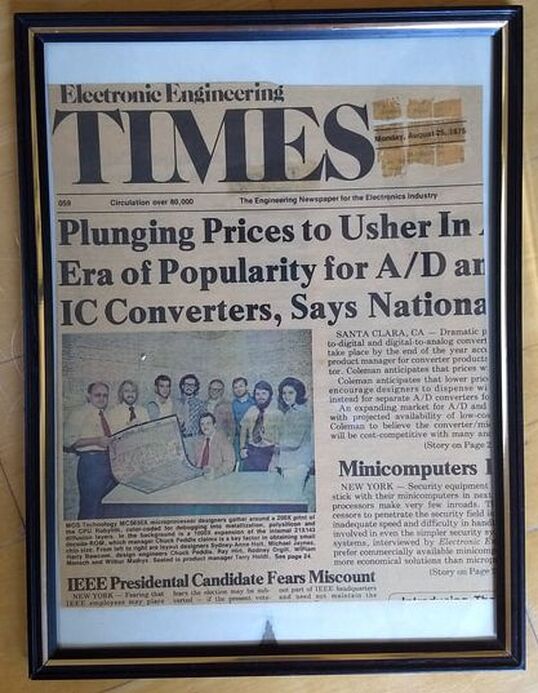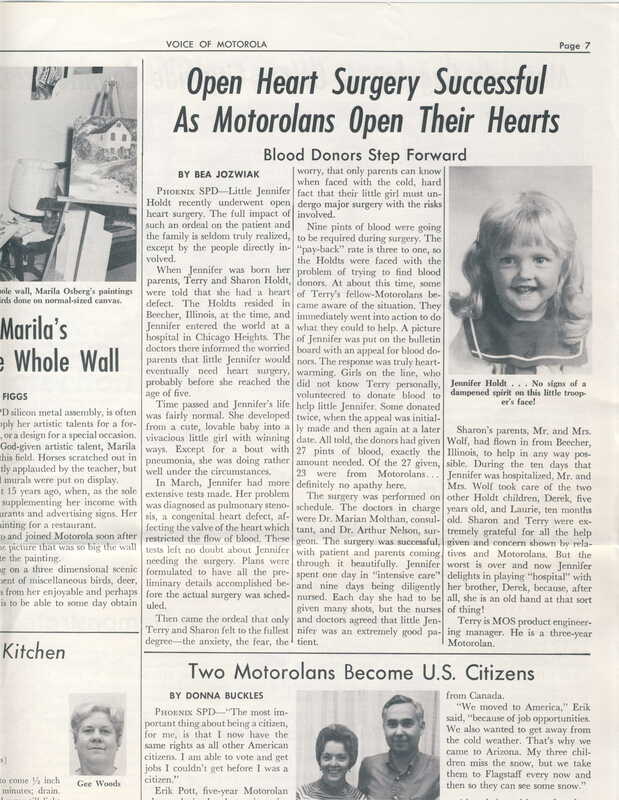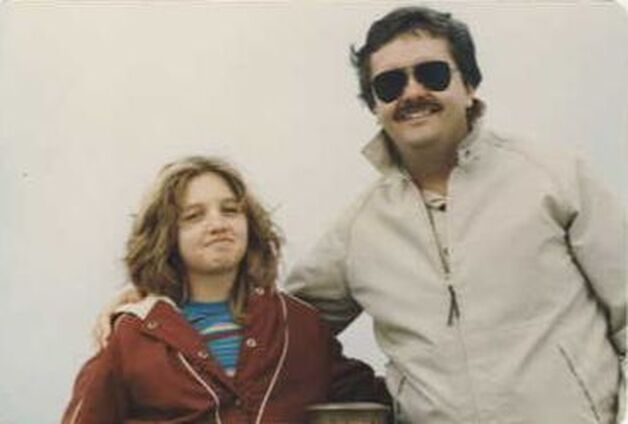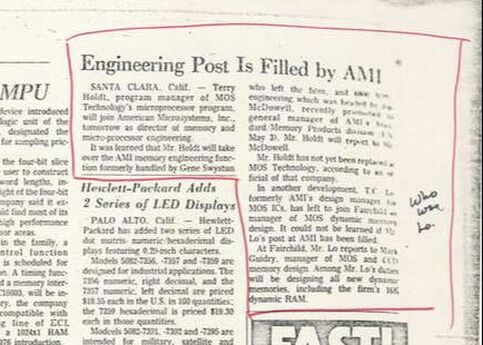How team6502.org Came to Be
by Jennifer Holdt-Winograd, daughter of MOS Technology Product/Program Manager
for Microcomputers & 6502 Process Development Manager, Terry Holdt

My family in 1971, during my Dad's tenure at Motorola. That's me, bottom right, looking done with the picture taking, thank you very much (behind me is my older brother, Derek, and to the left of me, my mother, Sharon, and little sister, Laurie). Time has worked magic regarding my father's style—you decide: 1970s electrical engineering nerd or 2020's hipster?
|
A few years ago as my brother and I were reminiscing about the past, he told me to Google the name of an old family friend I had not heard in many years but recognized from our youth: Chuck Peddle. What I found when I did so was stunning. The names which as a child I often overheard in the hazy white noise of adult conversation--words like MOS Technology and 6502--took on new meaning and significance when I realized that those words held historical relevance not just for me and my family. For as I belatedly came to learn, they were buzzwords associated with an important story of which our father, Terry Holdt, was a part: the MOS 6502, an eight-bit microprocessor which many credit with launching the personal computer and home video game industries.
Introduced in 1975 and featured in such seminal products as the Apple I and II, the Atari and Nintendo video game consoles, the Commodore PET, the Commodore 64, and the BBC Micro, the 6502 was not only widely used and, due to its low cost, hugely influential in its day, but it and its subsequent iterations have remained so nearly five decades later. In fact, as one of the most popular microprocessor architectures of all time, the number of 6500-family microprocessors so far produced is estimated at more than six billion. Yet as recently as just three years ago, all of this was news to me. As I read Wikipedia entries about the 6502 and MOS Technology, as I watched videos on YouTube about the chip’s history, read books, and visited websites and various Twitter accounts dedicated to discussing, analyzing, archiving, programming, and experimenting with the 6502, a greater context for some of the events of my early life emerged. The various cross-country moves my family had made during my childhood and certain memories--such as every kid in the neighborhood gathered around our television set awaiting their turn to play Pong--became part of a story larger than just that of my family's. My Dad’s home office, filled with what to me had been enigmatic memorabilia from his three decade long career as an electrical engineer, was, I came to learn, a mini-museum of computer history. The large schematic of the 6502 architecture hanging in my father’s office for most of my life--an image to which familiarity had rendered me blind--became suddenly fascinating; while the commemorative, resin-coated microchips and antiquated looking gadgets on his shelves, including a KIM-1 prototype--the world's first commercially available single-board computer introduced by MOS Technology in 1976--were more than odd, dusty relics from early in my Dad’s career, they were, I came to understand, important historical artifacts. The more I learned about the 6502, the more curious I became, with one question repeating in my head: what role, exactly, did my father play in the 6502’s creation? For while much has been written and otherwise recorded regarding two members of the 6502 team--first, Chuck Peddle--the man with a vision who inspired seven Motorola engineers, including my Dad, to quit their jobs in Phoenix, Arizona, and move their families all the way across the country to Valley Forge, Pennsylvania, to begin designing the world's first affordable microprocessor--and second, Bill Mensch, one of the 6502 design engineers whose company, the Western Design Center, continues to make iterations of the 6502 processor to this day, was that the whole story? What about the contributions of the other people who worked on the chip depicted in the 1975 image of the original design and production team featured in Electrical Engineering Times, a framed copy of which also sat in my Dad’s office? And what about the other MOS Technology employees at the time who were not in the photo but likely contributed to its production as well? The answer as to how I could go about answering those questions--or adding to the historical record about the 6502--eluded me until one day in early 2018 when I opened a cabinet in my father’s garage, revealing several shelves of forgotten MOS Technology documents that hadn’t seen the light of day in decades. In addition to user manuals, marketing posters, and other documents that have been archived and cataloged online and elsewhere was a wealth of historical information documenting the inner workings of MOS Technology and the creation of the 6500 family of microprocessors specifically as never before. Included in this find were interoffice memos, notes from brainstorming sessions between my Dad and other MOS engineers, various technical articles my father had read, annotated, and even written himself in the quest to solve the various production challenges the team faced, consumer instructional manuals noting errata, a 50-step production process, and pages and pages of testing results. I knew instantly that I had an obligation to make these documents public not only for my Dad and posterity's sake, but for the legions of 6502 enthusiasts alive today who would be thrilled to decode, debate, and discuss the additional details of the 6502 story my father’s documents reveal. Yet in making these documents public--documents which tell a story about the particular role my father played in the chip’s creation--I felt an obligation to use the opportunity created by this find to ensure that the many individuals whose names can likewise be found throughout my father’s papers are also recognized for their contributions. So I began to seek out these individuals to ask them to share their own stories, their own memories, and any historical documents they might have hidden away in forgotten cabinets or high upon dusty shelves that would add to the story of the 6502 as well. With a little internet sleuthing, I was able to locate some of the key players at MOS Technology who worked on the 6502, including Design Engineer Wil Mathys, Layout Designers Harry Bawcom and Sydney Anne Holt, or family members who agreed to share stories and documents on their behalf, such as the daughter of MOS Technology Process Research & Development Manager, Walt Eisenhower, and the widows of Design Engineer, Rod Orgill, and MOS Technology President, founder, and engineer, John Paivinen. Like my father's documents, many of the memories or artifacts shared by these individuals provide new insight into the production of the 6502 while others, such as Sydney Anne Holt's account of what it was like to be a female layout designer working in the semiconductor industry in the mid 1970s, provide a window into the larger culture that existed at the time. Also of note are photos of the 6502 schematics owned by Phyllis Orgill, a scan of the check providing the venture capital for MOS Technology contributed by Carol Paivinen, photos and memories inspired by Wil Mathys' recent visit to the now abandoned MOS Technology building (which later became Commodore Business Machines, makers of the Commodore PET and the Commodore 64 computers), and several MOS Technology marketing brochures provided by Walt's daughter, Diana. Of keen interest to me is the brochure given to attendees of the MOS Technology Open House in 1970, a brochure that--quite prophetically given the role the 6502 would play in launching the personal computing industry--references the significance of the company's location adjacent to Valley Forge National Historical Park by referring to MOS Technology as the "scene of the new revolution." Yet among the most rewarding developments to come from the creation of this website are the connections it has allowed me to make with the very people who, along with my Dad, created the 6502, as well as the wives, sons, and daughters of those people who, like me, are anxious to share the story of their loved one's contributions. As for those MOS Technology employees with whom I have yet to connect despite my best efforts, it is my hope that they might someday find this website and reach out to share the story of their contribution to the 6502 as well, stories I doubt they have been given the opportunity to share elsewhere. For as many of those I did locate told me, they, like my father, had never shared memories of their time at MOS Technology or of working on the 6502 despite public interest in the chip but for the simple reason that no one had ever asked them to. Engineers are by nature a forward-looking lot, with an eye on the future instead of the past. My father’s humble nature and the long and interesting career he had after leaving MOS Technology working as an engineer and manager at AMI, Zilog, Western Digital, National Semiconductor, and culminating in his tenure as CEO of S3 (later, SonicBlue), Silicon Valley’s leading producer of graphics accelerator chips in the early 1990s, meant that he rarely if ever talked about his days at MOS Technology when, to his older self, he was still a young engineer just starting out on what would become a long and fruitful career. As a result, for most of my life until very recently, I lacked understanding of the history my father helped to make. And but for a chance conversation with my brother, I do not doubt that the MOS Technology documents I found in my father’s garage would have ended up as fodder for the recycling bin instead of becoming that which they now are and should be: cherished family heirlooms. As we stand on the precipice of the third decade of the 21st century, those who half a century ago created the technology which led to the revolution in personal computing that has dramatically impacted the way we live our lives are either already gone or entering their 8th decade of life. If we don't record each of their contributions to our era of breathtaking technological innovation soon, they may be lost forever. Lost, too, might be any documents or artifacts currently in their possession or that of their families that could provide a more comprehensive and therefore accurate historical accounting of events; events that our descendants will likely regard as watershed milestones on the road to the future they inhabit. And so to two ends was this website created. First, to bring greater public awareness to the contributions of everyone, including my father, who worked on the 6502, the little chip credited with ushering in the most rapid democratization of technology in human history. And second, to the other unsung pioneers of the age who worked at other semiconductor companies on other transformative technologies whose stories have yet to be recorded for posterity. May this website inspire others of its kind, websites that honor the contributions of people like my Dad and the others who, as the documents shared herein reveal, summoned the imagination, creativity, hard work, and determination to usher the innovation predicted by Moore’s Law into reality. Jennifer Holdt-Winograd Oakland, CA October 2019 |
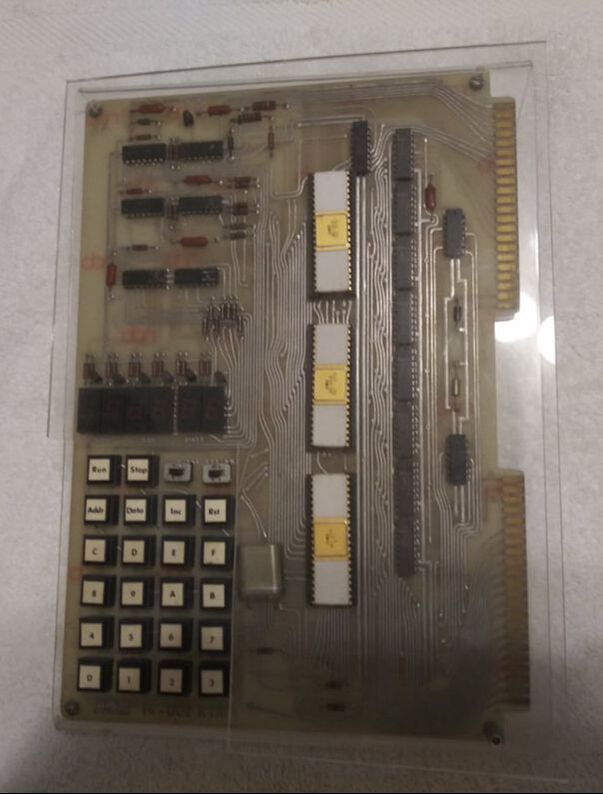
My Dad's Kim-1 prototype created as a means of showcasing the 6502's capabilities. When MOS Technology decided to market it for sale, it's popularity and commercial success among hobbyists and computer enthusiasts came as a welcome surprise for the company. Predating the release of the Apple 1 by several months, it is considered the world's first single board computer.
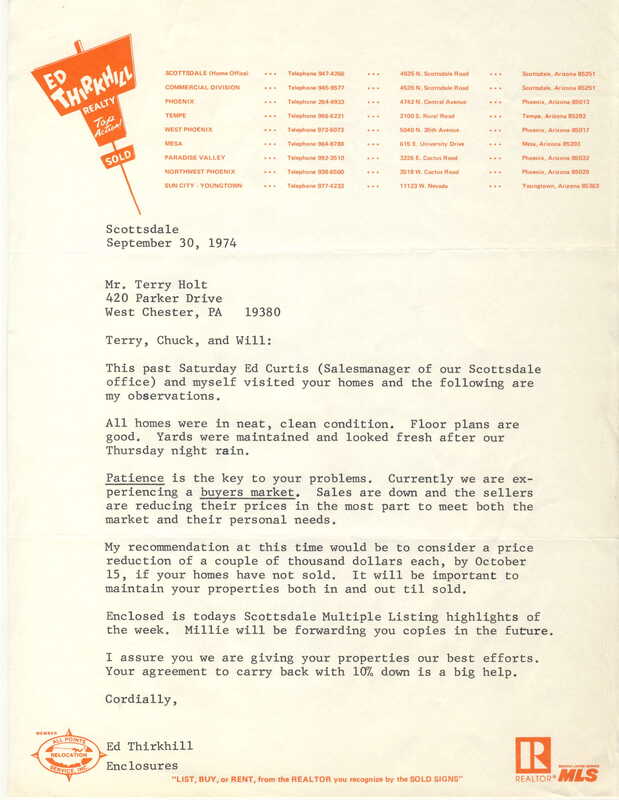
Also among my Dad's documents was this letter from the real estate agent used by my parents, Chuck Peddle, and Wil Mathys when they placed their homes on the market after deciding to leave Arizona for Pennsylvania. It was a hard decision for my parents to make, as they liked Phoenix and had just moved into a new house that they loved.

Goodbye, MOS: After a few years in Pennsylvania, my parents—Illinois natives who had already had more than their fair share of cold weather growing up—missed the milder winters they had experienced when living in the West during my Dad's time at Motorola in Phoenix. When my mother accompanied my Dad on a business trip to meet with Atari executives in the Bay Area, it was "game on" for California. Shortly thereafter, my Dad left MOS Technology to take a job, per this telegram, as Director of Memory and Microprocessor Engineering at American Microsystems, Inc. (AMI) in Santa Clara. Eventually and not surprisingly, several other MOS Technology employees would soon relocate to Silicon Valley as well, including Chuck Peddle, Steve Sherman, and John Paivinen.
|
WANTED:
MOS Technology Employees
Did you or someone you know or love work at MOS Technology during the creation of the 6502 and related products? Would you like to share that story? Please reach out to me through the contact page. I welcome your contribution!
Thank You!
I would like to express my gratitude to those who provided enthusiasm, information, and assistance with this website, including Harry Bawcom, Wil Mathys, Sydney Anne Holt, Diana Eisenhower-Hughes, Frank Slattery, Carol Paivinen, and Phyllis Orgill. Their patience, not only with how long this project took, but with my endless emails requesting additional information and clarification, is much appreciated. An added measure of gratitude to Harry who also assisted me in reaching several key players in the 6502 story, and to my husband, Nathan, my partner in life, my partner in parenting, my partner in animal advocacy, and my partner in not only caring for my elderly father, but ensuring that his contributions to technology are recorded for posterity.

